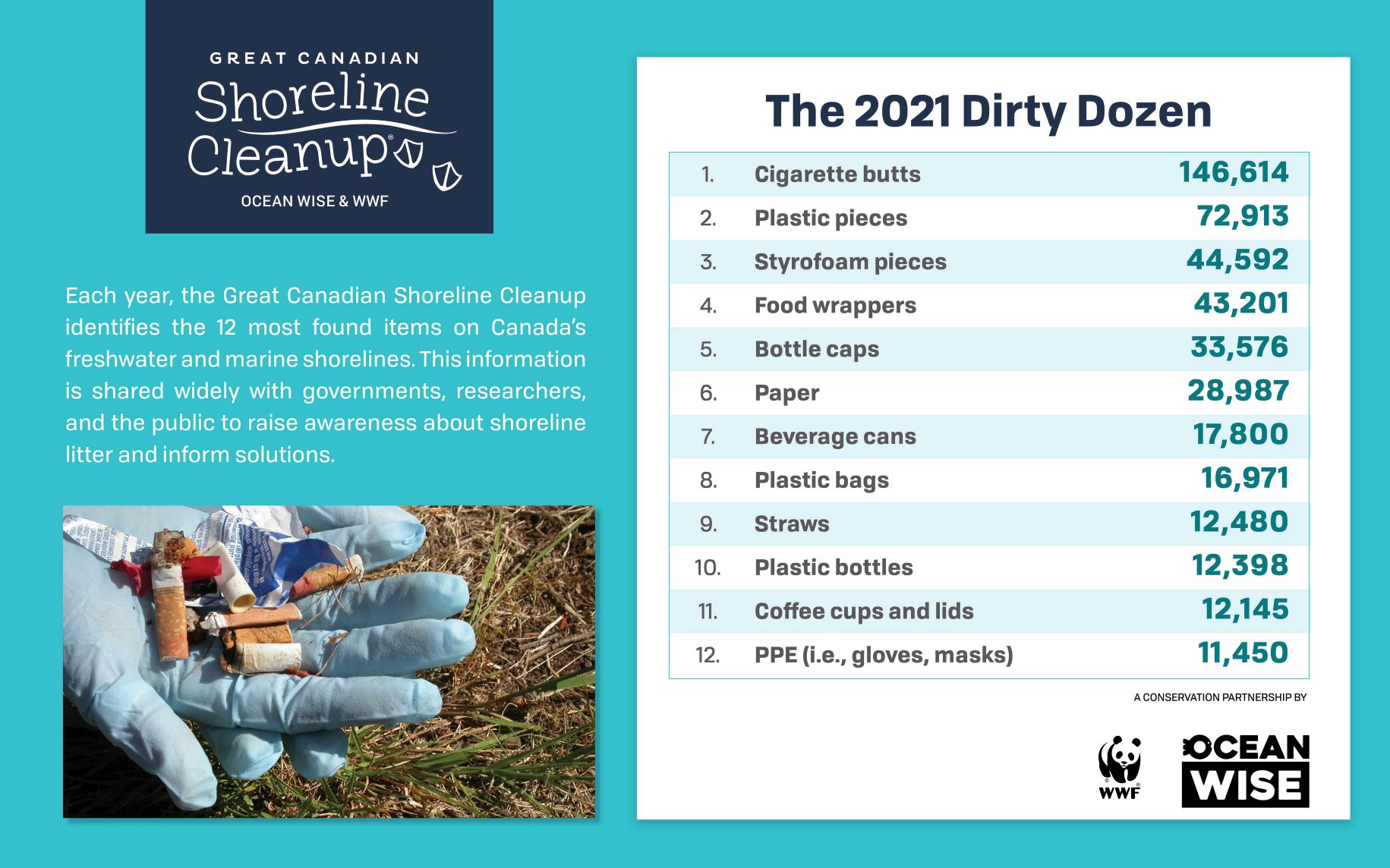Single-use food and beverage items, personal protective equipment (PPE), and cigarette butts are among the most common types of litter found on Canadian shorelines, according to the most recent Great Canadian Shoreline Cleanup’s “Dirty Dozen” list.
Each year the program releases this list using citizen science data collected from shoreline cleanups across the country to determine the 12 most frequently found items. This year, for the first time in the shoreline cleanup’s history, PPE was added as a category to volunteer data cards. Volunteers picked up 11,450 PPE items, mostly face masks, from shorelines as part of the 2021 cleanup.
“For the first time in 28 years of shoreline cleanups personal protective equipment, or PPE, was included as a category on volunteer-reporting cards, having been reported regularly as the top find without a category in 2020. And indeed, PPE ended up making its way onto the ‘Dirty Dozen’ list,” said Laura Hardman, director of Ocean Wise’s plastic initiative. “This serves as a powerful reminder that our actions have direct consequences for our environment. The best way to stop the threat of pollution to our ocean is to prevent our waste from getting there in the first place.”
“We all have a role to play in ending plastic pollution,” says Steven Guilbeault, federal Minister of Environment and Climate Change. “Through the Great Canadian Shoreline Cleanup, Canadians are coming together to remove litter from our communities and collect important data that helps the Government of Canada take informed decisions to reduce plastic pollution. Local initiatives like this are critical in moving Canada towards a zero plastic waste future.”

Single-use food and beverage items — including food wrappers, beverage cans, bottle caps, plastic bottles, coffee cups and straws — are the largest offenders, up five per cent from last year’s cleanup. This follows a 12 per cent increase from 2019 to 2020. The Government of Canada’s proposed ban on harmful single use plastics and commitment to reduce plastic pollution and move toward a circular plastics economy offers hope to reverse this rising trend.
The 2021 Great Canadian Shoreline Cleanup saw 19,508 participants complete 1,998 cleanups across the country. Volunteers covered 2,219 km of Canadian freshwater and marine shoreline, including 237 new cleanup sites. In total, participants hauled in 31,522 kilograms of trash.
“Wildlife depend on healthy ecosystems and too often litter and other pollutants cause harm,” says Megan Leslie, WWF-Canada’s president and CEO. “By cleaning shorelines, volunteers are keeping those hazards out of important freshwater and marine habitats and playing an important role in helping nature thrive.”
Since its start in 1994, the shoreline cleanup has had a total of 972,000 participants and is aiming to reach its one millionth volunteer this year.
Great Canadian Shoreline Cleanup is presented by Loblaw Companies Limited and Coca-Cola Ltd., and is one of the largest direct-action conservation programs in Canada. A conservation partnership by Ocean Wise and WWF-Canada, Shoreline Cleanup aims to promote understanding of shoreline litter issues by engaging Canadians to rehabilitate shoreline areas through cleanups.
Register for the next Great Canadian Shoreline Cleanup today at ShorelineCleanup.org.
Visit here to read Great Canadian Shoreline Cleanup’s 2021 impact report.
Featured image credit: Great Canadian Shoreline Cleanup.









